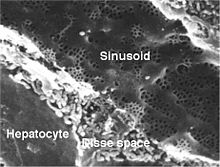Hepatocyte
Hepatocytes , and liver cells or hepatocytes called, are about 10 to 30 micrometers large cells that about 80 percent of the liver occupy volume. They come from the endoderm of the intestinal system .
Cell organelles
The hepatocytes are metabolically very active and contain numerous cell organelles :
- diploid to polyploid cell nuclei
- single lipid droplets
- Glycogen fields (the amount of glycogen depends on the diet and is subject to daily fluctuations)
- strongly developed Golgi apparatus
- secretory vesicles
- well developed cytoskeleton
construction
Like all epithelial cells, the hepatocyte has a polarized structure and function. They have a basolateral (sinusoidal) and an apical (canalicular) membrane, but no basal lamina.
The narrow apical bile pole carries numerous microvilli and secretes bile. The broad basolateral blood pole also borders a sinusoid through microvilli and is responsible for the exchange of substances between blood and hepatocyte.
function
The hepatocytes are involved in many metabolic processes and have the following important functions:
- Detoxification with numerous conversion reactions ( urea cycle , class I and class II transformation reactions)
- Synthesis of fatty acids
- Synthesis of bile acids
- Protein biosynthesis ( e.g. albumin , lipoproteins , coagulation factors , cholinesterases )
